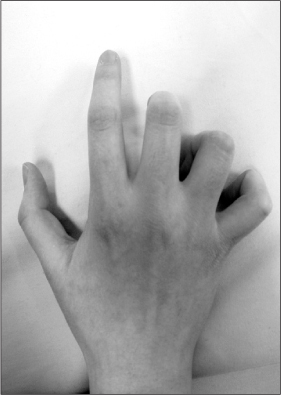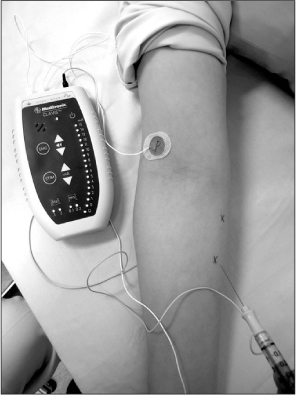J Korean Orthop Assoc.
2012 Jun;47(3):232-235. 10.4055/jkoa.2012.47.3.232.
Electromyogram-guided Botox Treatment for Focal Dystonia in a Pianist's Hand
- Affiliations
-
- 1Department of Orthopedic Surgery, Asan Medical Center, University of Ulsan College of Medicine, Seoul, Korea. jeonchoi@gmail.com
- KMID: 2106654
- DOI: http://doi.org/10.4055/jkoa.2012.47.3.232
Abstract
- Focal dystonia of musicians is one of the most disabling problems for professional musicians. It has focal task-specificity, presenting with involuntary flexion or extension of individual fingers when musicians play their instruments. It occurs mostly in pianists, and controversies still exist about the pathophysiology, whether it is caused by motor function disability or by a psychological condition. Although sensorimotor rehabilitation, change in instrument, skill or teacher, and immobilization with brace have been tried as treatment, there is still no definitive treatment. Because botox therapy has been effective in certain cases without irreversible side effects, this could be applied even in professional players. We report a case of focal dystonia of the hand in a professional pianist treated using electromyogram-guided botox injection and a review of the relevant medical literature.
Keyword
MeSH Terms
Figure
Reference
-
1. Schmidt A, Jabusch HC, Altenmüller E, et al. Etiology of musician's dystonia: familial or environmental? Neurology. 2009. 72:1248–1254.
Article2. Schuele S, Lederman RJ. Long-term outcome of focal dystonia in string instrumentalists. Mov Disord. 2004. 19:43–48.
Article3. Jabusch HC, Vauth H, Altenmüller E. Quantification of focal dystonia in pianists using scale analysis. Mov Disord. 2004. 19:171–180.
Article4. Truong D, Dressler D, Hallett M. Manual of Botulinum toxin therapy. 2009. New York: Cambridge University Press;61–75.5. Poore GV. Clinical lecture on certain conditions of the hand and arm which interfere with the performance of professional acts, especially piano-playing. Br Med J. 1887. 1:441–444.
Article6. Nourissat G, Chamagne P, Dumontier C. Reasons why musicians consult hand surgeons. Rev Chir Orthop Reparatrice Appar Mot. 2003. 89:524–531.7. Byl NN, Merzenich MM, Jenkins WM. A primate genesis model of focal dystonia and repetitive strain injury: I. Learning-induced dedifferentiation of the representation of the hand in the primary somatosensory cortex in adult monkeys. Neurology. 1996. 47:508–520.8. Rosenkranz K, Butler K, Williamon A, Rothwell JC. Regaining motor control in musician's dystonia by restoring sensorimotor organization. J Neurosci. 2009. 29:14627–14636.
Article9. Schmidt A, Jabusch HC, Altenmüller E, et al. Phenotypic spectrum of musician's dystonia: a task-specific disorder? Mov Disord. 2011. 26:546–549.
Article10. Altenmüller E, Jabusch HC. Focal dystonia in musicians: phenomenology, pathophysiology, triggering factors, and treatment. Med Probl Perform Art. 2010. 25:3–9.
Article
- Full Text Links
- Actions
-
Cited
- CITED
-
- Close
- Share
- Similar articles
-
- Delayed-onset focal dystonia after stroke
- Focal hand dystonia due to hemorrhage of the cervical spinal mass: a case report
- Non-Invasive Brain Stimulation for Treatment of Focal Hand Dystonia: Update and Future Direction
- Fibromyalgia Complicated with Dystonia Successfully Treated with Deep Brain Stimulation: a Case Report and Review of the Literature
- Delayed-onset focal dystonia after diffuse cerebral hypoxia: two case reports



